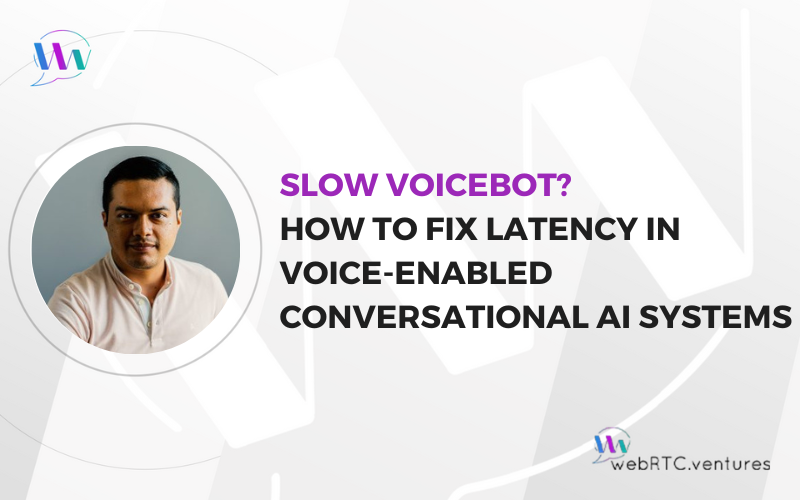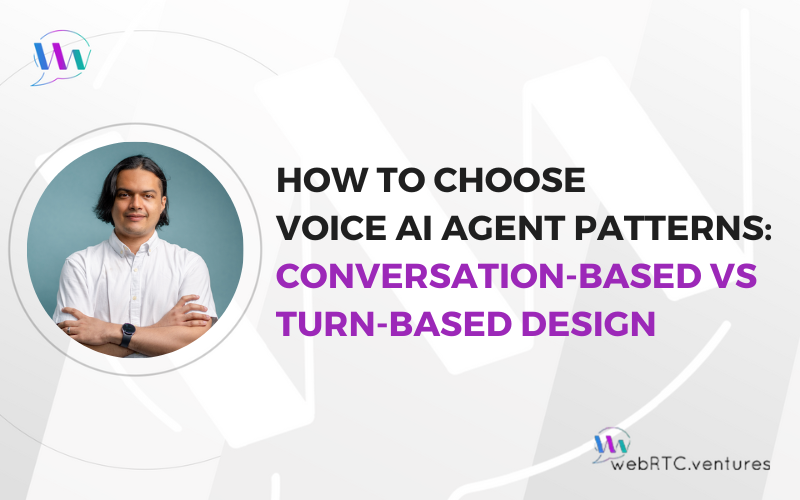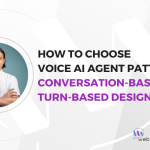Voicebot latency is the most critical performance metric for voice-enabled Conversational AI systems. While text-based interactions can tolerate response delays of several seconds, voice agents must respond as quickly as possible to maintain natural dialogue flow. Even slight delays create slow voicebots with perceptible awkwardness that degrades user experience and erodes trust in the system.
The challenge stems from Conversational Voice AI’s inherent architectural complexity. Voice-enabled agents often coordinate multiple AI technologies—speech recognition, language processing, and speech synthesis, and across multiple communication platforms like telephony and VoIP systems, with each component contributing measurable delay to the overall response time.
This post explores the technical architecture of Voice AI systems to identify specific latency sources of slow voicebots, then provides actionable optimization strategies across the entire conversational AI pipeline. We’ll examine how speech-to-text processing, LLM inference times, text-to-speech synthesis, and network transport each impact overall performance, and how to minimize their contribution to voice-to-voice delay.
Understanding Latency in Voice AI Systems
When measuring latency in Voice AI, we track “voice-to-voice” delay—the elapsed time from the moment a user stops speaking to when the agent’s audible response begins. As of 2025, the industry benchmark for production voicebot systems is approximately 800 milliseconds. Achieving sub-800ms performance requires optimization across multiple system components and careful architectural decisions
Let’s take a Customer Service voicebot as an example. In a scenario where users might already be frustrated with a product or service, a latency-optimized bot can make the difference between an issue resolved efficiently through self-service, or a user potentially leading to a competitor due to the company’s inability to fulfill their request.
Where Latency Comes From in Conversational AI Applications
Voice-enabled conversational AI systems operate as a series of intermediate processes, with each step contributing to the overall latency. Understanding these contributions is key to optimizing performance. The flow of a typical cascade-based (as described in our How to Build Voice AI Applications: A Complete Developer Guide post) voicebot interaction involves several distinct stages:
- User speaks, and such audio stream is transported to the Conversational AI application
- User’s speech goes through a speech recognition system which converts it into text
- A turn detection mechanism determines the right time for the system to start generating a response
- A Large Language Model (LLM) processes the text obtained in step 2, and generates an appropriate response
- A speech synthesis systems converts LLM’s response into audio
- The application “speaks” back to the customer
Now let’s take a look at how each of these steps impact the process.
- Speech Recognition Latency: This is the time it takes between the end of the user’s speech and when the Speech-to-Text (STT) component completes the generation of the corresponding text.
- Turn Detection Latency: An inherent, yet crucial, delay to ensure the user has truly finished speaking. This delay needs to be as minimal as possible to avoid awkward pauses, but long enough to not interrupt the user mid-sentence.
- Text Processing Latency: This includes the time it takes the LLM to gather all the required context, perform any necessary action and generate an appropriate response. All these operations can consume a considerable amount of time.
To mitigate this, text should be streamed to the Text-to-Speech (TTS) component as it’s generated, allowing for a more fluid interaction. In this regard, Time to First Token (TTFT) is a critical metric that tells how quickly the underlying AI model can begin formulating its responses.
It’s worth noting that more complex LLM considerations, often involving more advanced models or extensive reasoning, inherently lead to longer processing times.
- Speech Synthesis Latency: This is the final process of converting the agent response from text back into audio by the TTS component. The Time to First (audio) Byte (TTFB) is critical here, indicating how quickly the user starts hearing the agent’s response.
Beyond the core conversational AI components, several other factors can introduce latency:
- Inbound/Outbound Network Latency: This refers to the time it takes to transport media data through the network. The physical distance between users and cloud processing servers significantly impacts this, as do other factors like network congestion in local and provider networks.
- Function Calling and RAG (Retrieval Augmented Generation) Latency: When an LLM needs to perform actions on behalf of the user (e.g., looking up information in a database) or retrieve external knowledge, these external calls and data fetches add to the overall processing time.
- Telephone Integration Latency: Sending media data to external systems or platforms, such as traditional telephone networks, can also introduce additional delays due to the infrastructure and protocols involved.
One alternative approach is the use of Large Multimodal Models (LMMs) to manage the media pipeline. In this approach speech to text mechanism, text processing and text to speech conversion is performed by a single model. This allows to reduce latency, however LMMs capabilities might not be as good as state-of-the-art LLMs, and usually the former are considerably more expensive and context is more difficult to manage for them.
Tips for Optimizing Voicebot Latency
Achieving low latency voicebots is a continuous optimization process that requires a multi-faceted approach. Here are some key strategies and actionable advice:
- Use Latency-Optimized Models: Choose AI models specifically designed for speed and efficiency. For instance, consider highly optimized variants of STT models like OpenAI’s Whisper V3 Turbo and ElevenLabs’ Eleven Flash & Turbo.
- Utilize Smaller Models When Reasoning Requirements Are Not Overly Complex: For simpler tasks or those with clearly defined scopes, smaller models, such as Google’s Gemma or Amazon’s Nova Micro & Lite, can often provide sufficient accuracy with significantly reduced latency. This avoids the overhead of larger, more generalized models.
- Optimize the Context Window: Efficiently managing the amount of conversational history the AI needs to process can drastically reduce LLM inference time. Leverage techniques such as summarizing older conversation turns or implementing sliding windows to keep the context relevant but concise.
- Keep Application Components Geographically Close (or Hosted in the Same Compute Unit) to Reduce Network Latency: Minimizing the physical distance data has to travel between different services (e.g., STT, LLM, TTS) is crucial. Co-locating these services or ensuring they are in the same data center region significantly cuts down on network overhead.
- Edge Computing and Distributed Processing: Deploying AI components closer to the user or leveraging cloud providers private networks for long distance connections can dramatically cut down on network travel time.
- Real-Time Monitoring and Adaptive Optimization: Continuously monitor latency performance, keeping a close eye on key metrics such as TTFT for LLMs, TTFB in TTS, and overall round-trip times for network requests. Use this information to implement adaptive strategies that adjust resources or processing flows dynamically.
- Advanced Caching and Preprocessing Strategies: Pre-calculating or caching frequently used information, common responses, or specific phrases can significantly speed up response times by avoiding redundant computations.
Building Low Latency Voicebots
The difference between a voicebot that users tolerate and one they prefer often comes down to milliseconds. When conversational voice AI systems respond within that critical window, interactions feel natural and effortless. Users remain engaged, complete their tasks successfully, and trust the system to help them again.
Achieving this level of voicebot performance requires a holistic approach to system architecture. The strategies outlined in this post provide a roadmap for building low latency voicebots, but implementation complexity varies significantly based on your specific requirements, infrastructure, and scale.
WebRTC.ventures specializes in building production-ready conversational voice AI systems that deliver consistently low latency across diverse communication channels. Our team has deep expertise in real-time media processing, voice infrastructure optimization, and the architectural decisions that separate functional voicebots from exceptional ones. Contact us to discuss how we can help you build a conversational AI experience your users will actually want to use.
Further Reading:
- Why WebRTC Is the Best Transport for Real-Time Voice AI Architectures
- 3 Ways to Deploy Voice AI Agents: Managed Services, Managed Compute, and Self-Hosted
- How to Build Voice AI Applications: A Complete Developer Guide
- How to Automate Voice AI Agent Testing & Evaluation with Coval
- Reducing Voice Agent Latency with Parallel SLMs and LLMs












